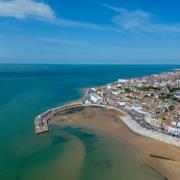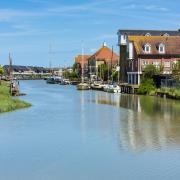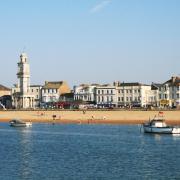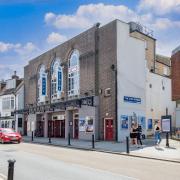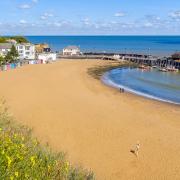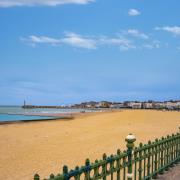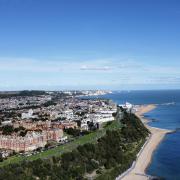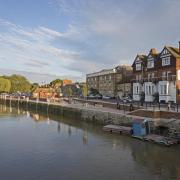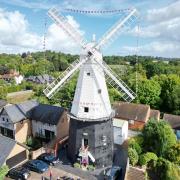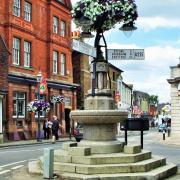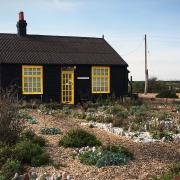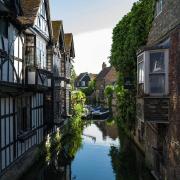Canterbury and its surrounding villages offer the visitor a perfect blend of
city, coast and countryside, however varied your interests may be.
Words by Geoffrey West pictures by Manu Palomeque
Whether you want to gaze at beautiful historic buildings, enjoy the splendour of a world-renowned Cathedral, take a river trip, admire spectacular gardens or simply wander around the thriving town centre, Canterbury has got it all. Surrounded by beautiful villages, as well as being close to the seaside resorts of Whitstable and Herne Bay, it also has all the 21st-century facilities you could want, including upmarket shopping centres and excellent road and rail links. Canterbury has a long-established musical and cultural tradition. Many of its musical events centre around the Cathedral, and The Marlowe Theatre Arena and Gulbenkian present shows of all kinds, including West End productions and cutting-edge comedy. Every October there’s a renowned festival, featuring music, literary celebrations and street entertainment.
Around townCanterbury has 23 car parks, plus three park-and-ride areas and a conveniently placed Tourist Information Centre on Sun Street, opposite the Christchurch Gate entrance to the Cathedral. Sun Street marks the beginning of the King’s Mile, a caf�-culture, Left-Bank-of-Paris area with pavement caf�s and a stylish collection of individual traders, including jewellers, antiques shops and boutiques. The centre of town is bisected by a single pedestrianised street packed with individual retailers and restaurants. It begins as St George’s Street, turns into the High Street and finally becomes St Peter’s Street, and most of Canterbury’s key attractions are clustered around here. On the High Street there’s a bridge over the River Stour marked by the historic Old Weaver’s House, from whose garden boats leave for river trips. Follow St Peter’s Street towards the medieval stone arch at the end (Westgate Towers) and you will pass The Eastbridge Hospital on the left and the construction site for the New Marlowe Theatre to the right, due to be completed in late summer 2011. The old Marlowe Theatre, built as a cinema in 1933 and upgraded as a theatre in 1982, was closed in March 2009 for demolition and rebuilding. In the meantime, the 2009 panto was staged at The Marlowe Theatre Arena, a big-top theatre tent in nearby Kingsmead Road, and other venues, such as Bramley’s Bay in Orange Street (which hosts Marlowe Comedy Club), are also being used. Whitefriars Shopping Centre dominates the other end of town: it’s an upmarket development with all the top-rank High Street names represented.You will find excellent cuisine at a number of restaurants, notably the Abode Hotel (01227 766266) and The Sun Hotel (01227 769700).There are several beautiful public open spaces: Greyfriars Friary, near the Eastbridge Hospital, is a lovely 13th-century estate spanning the river. Here you’ll find the remains of the actual Friary and the Chapel, where services are still held regularly. Dane John Gardens (left) has a tearoom and children’s maze, Westgate Gardens is beside the River Stour and just outside town are the ruins of 6th-century St Augustine’s Abbey, which, with St Martin’s church and the Cathedral, comprise the UNESCO World Heritage Site.
Major attractionsCanterbury Cathedral(01227 762862) Fully functioning as a place of worship, in addition to being a focal point for concerts.Eastbridge Hospital(01227 471688) Medieval pilgrims’ hospital with an undercroft, two chapels and a refectory, adjacent to the Greyfriars house, Chapel and Gardens. The Canterbury Tales (01227 479227) Exhibition celebrating Chaucer’s pilgrims.The Marlowe Theatre Arena (01227 787787) Temporary home for Marlowe Theatre productions. Gulbenkian Theatre (01227 769075) At University of Kent.St Martin’s Church(01227 462686) The oldest parish church in England.Canterbury Historic River tours (07790 534744) See the ‘inaccessible’ parts of Canterbury from a unique viewpoint, since the river runs at a lower level than many of the city’s streets.Museum of Canterbury with the Rupert Bear Museum (01227 475202) housed in the medieval Poor Priests’ hospital. See exhibits dating from pre-Roman times. Roman Museum (01227 785575) Reconstructions of a Roman market town, artifacts etc. Westgate Towers Museum (01227 789576) Armaments from the Civil War to the Second World War.Sidney Cooper Gallery (01227 453267) Exhibitions, lectures and workshops.
Considering a move?Property prices are marginally cheaper just outside the city, and even within are lower than London. Typically a one-bedroomed flat is �100-120,000, a two-bedroomed flat or house is �130-200,000, a three-bedroomed semi �220-250,000, while a large detached home can be upwards of �450,000. The Kings School is one of the best independent schools in the UK, and possibly the oldest.
My Town: Q&A with Rosie Turner, Director of the Canterbury Festival
What’s happening at 2010’s festival? There’ll be the usual mix of music, quirky theatre and exhibitions and we’re going to be developing our focus on literary activities. Our current Canterbury Laureate is Patience Agbabi, a performance poet who takes her inspiration from Chaucer – she launched her laureateship at last year’s festival. We always have a series of celebrity talks, and we think within this year’s programme there should be a place for discussion and debate on poetry and literature.
What would you tell potential visitors? Canterbury is a wonderful city for visitors at any time of the year, but festival fortnight (16-30 October) is always special. There’ll be almost 200 events, many of which will be free, notably artists’ open-house events, exhibitions and guided walks. Hotels, restaurants and B&Bs are all offering special deals for festival goers.
Where is your favourite place in town? The cloisters of Canterbury Cathedral. It’s a wonderful place to just have a moment of reflection and get away from the hustle and bustle of the day. For shopping, I’m very fond of Fenwick. My favourite restaurant is Deesons (01227 767854) for its superb cuisine and extra-friendly staff.
What do you like about Canterbury? It’s a marvellous place to live, just over an hour from London, and an hour from France – ideally suited to benefit from the international arts scene. I love its compact nature, and the fact that I know many of our festival supporters personally.
Nearby villages & places to see
Chilham has an abundance of historic architecture and is one of the most popular places to visit in Kent. The village square is notable for its medieval and Jacobean half-timbered buildings and is so scenic it often used for film productions (Jane Austen’s Emma was shot there last year for the BBC); part of the village is designated as a Heritage Conservation Area. Wonderful old buildings include the White Horse Inn (16th century), Chilham Castle and Manor House (the gardens, designed by Capability Brown, are open occasionally during summer), Tudor Lodge and Tudor Cottage in the village square, plus many others in the High Street. The gateway to Chilham Park was built by Inigo Jones in 1616. Chilham’s St Augustine ‘mystery’ is that the gilded shrine housing St Augustine’s body was moved to the 13th-century parish church of St Mary’s during the reformation, but vanished in 1541.
Fordwich is the smallest ‘town’ in England, earning the title because of its beautiful brick-and-timber town hall, which, ironically, is probably the smallest such civic building in the country! Originally its importance was as a port serving Canterbury, and it became an arm of the Cinque Port of Sandwich. This scenic riverside settlement has wonderful old timbered buildings, and its parish church of St Mary, behind the welcoming Fordwich Arms hostelry, houses the famous and arcane ‘Fordwich Stone’, a solid block of limestone carved to resemble a tomb. You’ll find fantastic historic buildings beside an idyllic river, with wonderful views wherever you look. Try taking the unforgettable Stour Valley Walk from Canterbury to Fordwich.
Sturry incorporates the mining village of Hersden, plus several hamlets. To the north of the old part of Sturry quarries are still active, and older quarry workings having been flooded to create lakes; several market gardens are also on the edge of the village. To the north of Old Sturry are several relatively new housing estates – these aren’t numerous enough to spoil the rural feel of the place, and are tailormade for anyone considering making a move to the area. Even though Sturry was badly bombed in the Second World War, there is still a fine High Street and plenty of interesting old buildings.These include St Nicholas’s parish church (its oldest part dating to 1200), and the Manor House, built in 1583, which is now used as the junior school of The Kings School, Canterbury, and the oast house – used as a pre-preparatory school. There are also the remains of a large village watermill.
Harbledown is adjacent to Canterbury and forms part of the parish of Harbledown and Rough Common. It is said to be a place where Chaucer and his pilgrims rested on the way to Canterbury, and its name derives from its bad road, where wanderers would ‘bob up and down.’ The High Street is a Conservation Area with interesting houses, including an excellent Georgian terrace. The Hospital of St Nicholas was founded by Archbishop Lanfranc in 1084 for the care of lepers, who earned money by displaying a slipper that had been worn by St Thomas Becket; passing pilgrims would give a few coins for the privilege of seeing it.Today, it is an almshouse with a range of cottages for the elderly. It is rumoured that Henry II walked barefoot through Harbledown on a pilgrimage to Canterbury Cathedral in repentance for his involvement in the murder of Thomas Becket.
Chartham, to the west of Canterbury, is situated on the River Great Stour, and its name means ‘village on the rough ground.’ Its northern part is called Chartham Hatch. Paper-making has been its principle industry for six centuries, the mill machinery being powered by the river. The Paper Mill began in the late 1700s and continues today, specialising in the production of tracing paper, now a very specialised engineering process. The church of St Mary the Virgin has the oldest peal of bells in Kent. The village is part of the Kent Downs Area of Outstanding Natural Beauty.
Wingham became established as a village in Roman times, and is most notable for its church, St Mary the Virgin, dating from the 1200s, which has rare reredos (decorative screens). Its spire is visible from miles around. Many Wingham buildings date back to this era, including the Red Lion. In the early 20th century, three railway stations opened to serve the new coal mines in the vicinity, but unfortunately the line failed. The town has a memorably lovely High Street, and is principally a dormitory town for Canterbury.
Blean Woods is the largest forested area in Kent, and these ancient woodlands surround several attractive villages. The area is internationally recognised as important for wildlife, and there are special wildlife walks. It is designated as a National Nature Reserve, managed specially for its wildlife, a Site of Special Scientific Interest, a County Wildlife Site and a local Nature Reserve.
Goodnestone Park Gardens(01304 840107) 15 acres of historic gardens with old-fashioned roses, trees, walled garden and an arboretum. Considered to be one of the outstanding country gardens in England, it is open from 23 March, excluding Saturdays and Mondays (see also our garden of the month, page 90).
Howletts and Port Lympne Wild Animal Park
(0870 750 4647) See some of the world’s rarest wild animals and endangered species.



